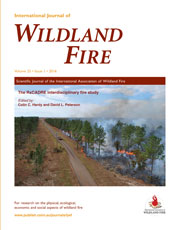
International Journal of Wildland Fire
Volume 25 Number 1 2016
The RxCADRE Interdisciplinary Fire Study
WF14161Measurements, datasets and preliminary results from the RxCADRE project – 2008, 2011 and 2012
The Prescribed Fire Combustion and Atmospheric Dynamics Research Experiment (RxCADRE) provides integrated, quality-assured fuel, meteorology, fire behaviour, energy, smoke emissions and fire effect datasets to evaluate fire models and inform wildland fire combustion theory. This overview paper summarises the RxCADRE project and the nine companion papers associated with data collection.
WF15092Pre-fire and post-fire surface fuel and cover measurements collected in the south-eastern United States for model evaluation and development – RxCADRE 2008, 2011 and 2012
We present field measurements of fuel loading, moisture content, consumption and post-fire surface cover fractions collected on 16 prescribed fires. We found total fuel consumption predictions from CONSUME and FOFEM were within 1 Mg ha–1 of observed fuel consumption, as were retrospective predictions based on residual white ash cover.
WF14159Measurements relating fire radiative energy density and surface fuel consumption – RxCADRE 2011 and 2012
We present ground-based and remotely sensed data used to predict surface fuel loads and fire radiative energy density (FRED) from the 2011 and 2012 RxCADRE prescribed fires. Relationships between observed and predicted surface fuel loads, and fuel consumption observed and predicted from FRED, approached linearity at multiple scales.
WF14170Development and validation of fuel height models for terrestrial lidar – RxCADRE 2012
We discuss the efficacy of terrestrial laser scanning for collecting continuous measurements of grass and shrub fuelbeds in north-western Florida as part of the 2012 RxCADRE experiments. Spatial bias is examined, resulting in fuel height data that correspond closely with field measurements of height.
WF15090Measuring radiant emissions from entire prescribed fires with ground, airborne and satellite sensors – RxCADRE 2012
Developing accurate ground, airborne and satellite measurements of fire radiation is key for fire science. We describe two methods of estimating power emitted by prescribed fires appropriate for small burn blocks (2 ha) and two for large (>100 ha) blocks. Measurements have different strengths and weaknesses and require more development and evaluation.
WF14165High-resolution infrared thermography for capturing wildland fire behaviour: RxCADRE 2012
Herein we describe the usefulness of long-wave infrared (LWIR) imagery for capturing fire behaviour in space and time. We explore how images captured at different perspectives and varying spatial resolutions affect measurements of fire. We discuss of the usefulness of multiple measurements and potential in quantifying fire patterns of fire spread and fire effects.
WF14154Observations of energy transport and rate of spreads from low-intensity fires in longleaf pine habitat – RxCADRE 2012
Measurements of fire intensity, flame geometry and rate of spread using several methods are compared. Measurement uncertainty and variability are explored.
WF14173Fire weather conditions and fire–atmosphere interactions observed during low-intensity prescribed fires – RxCADRE 2012
Meteorological observations were made during the RxCADRE campaign using both in situ and remote-sensing instrument arrays. The measurements provide comprehensive high-spatial-resolution datasets for coupled fire–weather model initialisation and evaluation. Preliminary results indicate that even the low-intensity fires observed during the campaign were able to induce fire–atmosphere coupling and modify the fire spread.
WF14166Grassland and forest understorey biomass emissions from prescribed fires in the south-eastern United States – RxCADRE 2012
Smoke emission measurements were made during grass and forest understorey prescribed fires. Instruments deployed on ground, airplane and tethered aerostat platforms measured carbon species, particulates and optical properties. Smouldering emission factors were higher from the understorey fire. This demonstrates the influence of the fine fuel mosaic on emission factors.
WF14176Evaluation and use of remotely piloted aircraft systems for operations and research – RxCADRE 2012
Remotely piloted aircraft systems (also known as unmanned aircraft systems) were integrated into a complex operations environment that focussed on including piloted aircraft to meet wildland fire research objectives and assess their use in supporting prescribed fire operations. US Air Force safety protocols formed the basis for mission planning.



